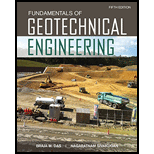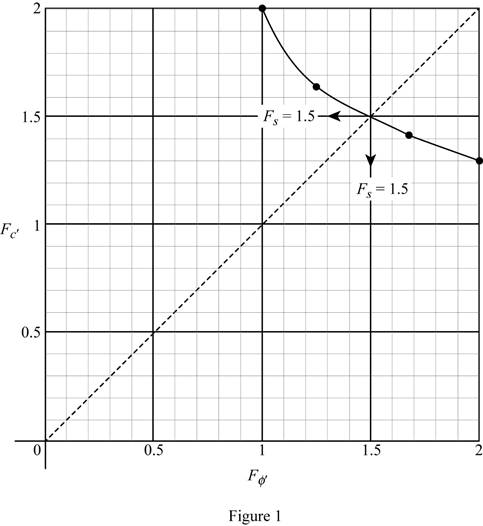
(a)
Find the factor of safety with respect to sliding for case (a).
(a)
Answer to Problem 13.22P
The factor of safety with respect to sliding for case (a) is
Explanation of Solution
Given information:
The bed slope
The angle
The cohesion
The unit weight of the soil
The depth (H) of slope is 15.2 m.
Calculation:
Calculate slope angle
Substitute 2 for
Assume the developed angle of friction
Find the factor of safety
Substitute
Find the Taylor’s stability number (m).
Refer Figure 13.17, “Taylor’s stability number” in the textbook.
Take the value of Taylor’s stability number corresponding friction angle
The Taylor’s stability number (m) is 0.098.
Find the developed cohesion
Substitute
Find the factor of safety with respect to cohesion
Substitute
Similarly find the factor of safety
Summarize the values of the factor of safety
| m | ||||
| 5 | 2.01 | 0.098 | 25.76 | 1.30 |
| 6 | 1.68 | 0.090 | 23.65 | 1.41 |
| 8 | 1.25 | 0.078 | 20.50 | 1.63 |
| 10 | 1 | 0.064 | 16.82 | 1.99 |
Plot the graph of factor of safety

Refer Figure 1.
Find the factor of safety
Draw a line from origin of the graph with an angle of
Therefore, the factor of safety with respect to sliding for case (a) is
(b)
Find the factor of safety with respect to sliding for case (b).
(b)
Answer to Problem 13.22P
The factor of safety with respect to sliding for case (b) is
Explanation of Solution
Given information:
The bed slope
The angle
The cohesion
The unit weight of the soil
The depth (H) of slope is 9.15 m.
Calculation:
Calculate slope angle
Substitute 1 for
Assume the developed angle of friction
Find the factor of safety
Substitute
Find the Taylor’s stability number (m).
Refer Figure 13.17, “Taylor’s stability number” in the textbook.
Take the value of Taylor’s stability number corresponding friction angle
The Taylor’s stability number is 0.133.
Find the developed cohesion
Substitute
Find the factor of safety with respect to cohesion
Substitute
Similarly find the factor of safety
Summarize the values of the factor of safety
| m | ||||
| 5 | 4.16 | 0.133 | 22 | 0.87 |
| 10 | 2.06 | 0.105 | 17.37 | 1.10 |
| 15 | 1.36 | 0.080 | 13.23 | 1.45 |
| 20 | 1 | 0.058 | 9.7 | 2 |
Plot the graph of factor of safety

Refer Figure 2.
Find the factor of safety
Draw a line from origin of the graph with an angle of
Therefore, the factor of safety with respect to sliding for case (b) is
Want to see more full solutions like this?
Chapter 13 Solutions
Fundamentals of Geotechnical Engineering (MindTap Course List)
- Figure 2 shows a slope with an inclination of : β = 58 ͦ. If AC represents a trial failure plane inclined at an angle θ = 32 ͦ with the horizontal, determine the factor of safety against sliding for the wedge ABC. Given: H = 6 m; ɣ = 19 kN/m3, Ø =21 ͦ, and c’= 38 kN/m2arrow_forwardQuestion No. 16 A long slope is formed in a soil with shear strength parameters: c' = 0 and d' = 34°. A firm stratum lies below the slope and it is assumed that the water table may occasionally rise to the surface, with seepage taking place parallel to the slope. Use Ysat = 18 kN/m³ and Yw = 10 kN/m³. The maximum slope angle (in degrees) to ensure a factor of safety of 1.5, assuming a potential failure surface parallel to the slope, would bearrow_forwardA slope is shown in the figure below. If AC represents a trial failure plane, determine the factor of safety against sliding for the wedge ABC. Given: β= 570 , ϒ = 17.5 kN/m3 , φ’ = 13.50 , and c’ =27 kN/m2Please use the Culmann’s method B. Briefly Comment on how to analyze a slope and determine the factor of safety against overturning.arrow_forward
- 1. Find the Factor of safety against sliding along the interface for the infinite slope shown in Figure. Also find the height Z that will give F.S of 2 against sliding along the interface. B=25" Z=2.43 m Y= 16 KN/m 10 kN/m² 1-159 Interfacearrow_forwardQ.2 Figure 2 shows a slope with an inclination of : β = 58 ͦ. If AC represents a trial failure plane inclined at an angle θ = 32 ͦwith the horizontal, determine the factor of safety against sliding for the wedge ABC. Given: H = 6 m; ɣ = 19 kN/m3 , Ø =21 ͦ, and c’= 38 kN/m2 .arrow_forward1.) A concrete dam retaining water is shown. If the specific weight of the concrete is 23.5 kN/m3. Assume there is a hydrostatic uplift that varies uniformly from full hydrostatic head at the heel of the dam to zero at the toe and that the coefficient of friction between dam and foundation soil is 0.45. What is the magnitude of the uplift force at the bottom of the dam? CHOICES: a.) 1530.10 b.) 3010.50 c.) 1,030.05 d.) 5030.10arrow_forward
- 5 p A dam cross-section is a square facing a water depth of D=15m. Assuming a 1m strip for analysis and coefficient of friction is 0.5, determine the dimension "X" in meters so that factor of safety against sliding is equal to 2. 24KN/m3 9.81kN/m³arrow_forwardAn infinite slope of soil, with height 10 m, is inclined at an angle of 35° to the horizontal. The soil has c' = 22 kN/m², ' = 22º. A stability analysis by the method of slices has given the following forces per running meter Σ Shearing forces = 350 kN Σ Normal forces = 755 kN Σ Neutral forces = 175 kN If the length of arc is 19 m then the ratio of F.O.S with respect to cohesion to the F.O.S with respect to shearing strength isarrow_forwardQ.1. Refer to the infinite slope shown in Figure 1. Given: β = 19 ͦ, ɣ = 20 kN/m3 , Ø = 33 ͦ, and c’ = 47 kN/m2 . Find the height, H, such that a factor of safety, Fs = 3.1 is maintained against sliding along the soil-rock interface.arrow_forward
- Given an infinite slope with the following properties: γ = 17 kN/m3, H = 5 m, β = 34°, φ = 25° and c = 20 kPa. a. Determine the normal stress. b. Determine the shear stress. c. Determine the factor of safety.arrow_forwardA deep cut of 10 m depth is made in sandy clay for a road. The sides of the cut make an angle of 60° with the horizontal. The shear strength parameters of the soil are c' = 20 kN/m², Ø' = 25°, and y= 18.5 kN/m³. If AC is the failure plane (SEE FIGURE BELOW), estimate the factor of safety of the slope using Culmann's method. 10 m 60⁰ 40⁰ 10° c²= 20 kN/m² p' = 25° y = 18.5 kN/m³arrow_forward1.) A concrete dam retaining water is shown. If the specific weight of the concrete is 23.54 kN/m3, find the factor of safety against sliding. Assume there is a hydrostatic uplift that varies uniformly from full hydrostatic head at the heel of the dam to zero at the toe and that the coefficient of friction between dam and foundation soil is 0.45. CHOICES: a.) 3.551 b.) 5.351 c.) 3.155 d.) 1.355 2.) A concrete dam retaining water is shown. If the specific weight of the concrete is 23.54 kN/m3, find the factor of safety against overturning. Assume there is a hydrostatic uplift that varies uniformly from full hydrostatic head at the heel of the dam to zero at the toe and that the coefficient of friction between dam and foundation soil is 0.45. CHOICES: a.) 1.296 b.) 2.961 c.) 6.296 d.) 2.196 3.) A concrete dam retaining water is shown. If the specific weight of the concrete is 23.5 kN/m3. Assume there is a hydrostatic uplift that varies uniformly from full hydrostatic head at the heel of…arrow_forward

 Structural Analysis (10th Edition)Civil EngineeringISBN:9780134610672Author:Russell C. HibbelerPublisher:PEARSON
Structural Analysis (10th Edition)Civil EngineeringISBN:9780134610672Author:Russell C. HibbelerPublisher:PEARSON Principles of Foundation Engineering (MindTap Cou...Civil EngineeringISBN:9781337705028Author:Braja M. Das, Nagaratnam SivakuganPublisher:Cengage Learning
Principles of Foundation Engineering (MindTap Cou...Civil EngineeringISBN:9781337705028Author:Braja M. Das, Nagaratnam SivakuganPublisher:Cengage Learning Fundamentals of Structural AnalysisCivil EngineeringISBN:9780073398006Author:Kenneth M. Leet Emeritus, Chia-Ming Uang, Joel LanningPublisher:McGraw-Hill Education
Fundamentals of Structural AnalysisCivil EngineeringISBN:9780073398006Author:Kenneth M. Leet Emeritus, Chia-Ming Uang, Joel LanningPublisher:McGraw-Hill Education
 Traffic and Highway EngineeringCivil EngineeringISBN:9781305156241Author:Garber, Nicholas J.Publisher:Cengage Learning
Traffic and Highway EngineeringCivil EngineeringISBN:9781305156241Author:Garber, Nicholas J.Publisher:Cengage Learning





